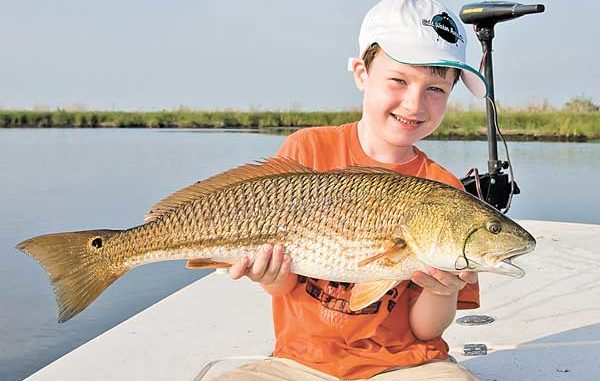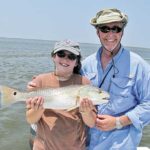
Hard-charging Delacroix redfish just can’t resist spoons this time of year.
Gold spoons are like the Dallas Cowboys; you either love them or hate them, and there isn’t any room in the middle. It just so happens that I fall in the hate group for both — not so much that I have anything against gold, spoons or any combination thereof.
I just can’t catch redfish on the stupid things.
What makes my hate of gold spoons even more intense is that I know redfish eat them up, or so I’ve been told.
“They love them,” verified somebody at Venice.
“All you got to do is pop them off the bottom,” an angler concluded at Calcasieu.
“No better bait for reds,” they gushed in Golden Meadow.
Realizing that my lack of luck with gold spoons probably had more to do with operator error than it did with the spoons, I headed to Delacroix determined to decrease my doubt. I couldn’t go it alone, though, or my opinion would have remained the same, so I called Capt. Jack Payne with Sweetwater Guide Service to see if he would spoon feed me in the basics of spoon-fed reds.
“Not a problem,” Payne drawled with a laid-back South Louisiana tone. “We got reds all over the place right now — Grand Lake, Spanish Lake, the back of Reggio. They even got some reds in Lake Lery right now. Don’t think it will be a problem finding some that want to eat some spoons.”
Having read somewhere that spoons were good baits for beginners to throw on reds, I awoke my 7-year-old son Matthew at 3:30 for the hour-and-a-half drive down to Delacroix. We were to meet Payne at his new boat ramp at 5:30.
A side-stop at a supposedly 24-hour big-box store to get some spoons left us hoping that Payne had some to share because we were going in empty-handed. Tossing me a sack that nearly knocked me out the boat, Payne told us he had plenty.
“September is an excellent time to throw spoons around Delacroix for a couple reasons,” Payne advised as he turned his flats boat toward the east. “For one, the bait is kind of dissipating, and the reds are usually more aggressive when there is less bait.
“Two, the grass around Delacroix is as thick as it’s going to get during September. That means a lot of baits you might otherwise like to throw — spinners, plastics, whatever — get harder to fish in the thick stuff. A spoon is just about all you can get through the grass.”
With just enough Washington Parish “Jones” in me to be hard-headed, I began the morning casting a spinnerbait. I cleared snot grass; Payne caught fish. I switched to a soft plastic fished on a jighead. I cleared snot grass; Payne caught fish. I tried one of those chatter baits. I cleared snot grass; Payne caught fish.
The only thing I hate worse than spoons is watching somebody smoking them on spoons while I sit idly by stupidly refusing to tie one on. Realizing Payne knew a lot more about spoons than I did, I asked if he had any opinions on why these particular reds were so infatuated with them.
“They’re swimming garbage cans,” he said of the reds. “If you can get a bait by him, he’s going to strike it. Right now, my bait is flashing by looking all nice and pretty while yours looks like a stick coming through the water with all that grass on it.
“Other than that, I think it kind of looks like a crab the way they sometimes flutter through the water. It might also look like an injured mullet or something like that that’s swimming on its side after it’s been hit by another fish. I’m not really into why they’re eating it, though, as long as they are.”
And they were, so I had to swallow my foolish pride. I tied on one of the spoons from the bag Payne had injured me with earlier; “The Secret” it had stamped on it. There was a swivel attached to the line-tie, so I threaded my line through and pulled it down into a perfect palomar.
Payne had instructed me to tie my 30-pound-test Power Pro directly to the swivel rather than tie on a heavy monofilament or fluorocarbon leader first. His contention was that redfish don’t shy off the braid when fishing spoons around heavy grass because it just kind of blends in with its surroundings.
“You don’t have to use braid, but braid gives you better casting distance in my opinion,” he said. “And it helps you drag these big reds out of the thick stuff. Now if the water were crystal clear like what you might see in Florida, I would recommend tying on about a 5-foot fluorocarbon leader because the braid will stand out in that situation.”
Although The Secret spoon came with a swivel already on it, Payne says if your spoon comes without one, you shouldn’t even think about casting it in the water before you tie one on. Spoons twist a lot during the retrieve, and fishing without a swivel will create huge twists in your line that will leave you miserable all day long.
Payne spoon-feeding me with mundane basics was getting a little too simple. I had to do some thinking for myself, as anybody can get a spoon out of a bag and tie it on their line. With so much conflicting advice over the years, I asked Payne to break down how to fish spoons rather than how to rig one.
“I think the most important thing is to change up your retrieve until you discover what the fish want,” he said. “A slow, steady retrieve is good, but there’s more you can do. One thing that works well around Delacroix is to let it fall down in the grass and jerk it out.”
Jerking a spoon out of the grass is typically a harder yank than just popping it off the bottom, and Payne feels it is that extra-hard jerk that attracts nearby redfish. When he jerks it really hard to get it out of the grass, not only do reds see the spoon flashing, they also see all that grass moving around it, and they have to come over and investigate.
“Then you let it drop back down to the bottom, and wham, they eat it up,” Payne added. “You can fish it like that even if you aren’t in the grass. I like to let it flutter down no matter what I’m fishing around.
“If you want to do the straight retrieve, though, I would recommend you don’t reel it too fast. Fish it slowly enough to keep a nice bow in your line to get the maximum flutter on a straight retrieve. The main thing is to not be too aggressive with it and keep it about a foot under the surface — keep it wobbling.”
Right before I made my first cast, Payne offered a little more help. He had seen me blind-casting all around his boat just moments before, and he wanted to help me get my casts a little closer to our intended target.
While blind-casting can be productive any time if the redfish are really cruising around, these reds weren’t moving in packs down the bank like you might expect. Rather, they were pushing around in small areas without showing very much back, tail or wake.
“Look for the crazy water,” Payne instructed. “What I call crazy water is when I see waves that aren’t flowing the same direction as all the others. That’s usually a fish. It might not always be a redfish, but crazy water is a good sign something is going on, and that’s a good place to cast.”
Payne’s spoon-feeding me in the basics of spoon fishing worked very well. Reds that had earlier been watching giant balls of snot grass moving through the water now saw gold flashes that they just knew were food. Not only did they fall for my baits, they fell for my son’s, too.
However, a couple of missed fish led Payne to offer up one more bit of advice.
“Make sure your hooks are sharp,” he said. “Sometimes, right out of the pack, spoon hooks are dull because of the gold plating. Give it the finger test, and if it doesn’t feel sharp to you, hit it a few times with a sharpener to knock that gold off and sharpen it up. If you’re setting the hook and wondering why you’re not sticking them, that’s probably the reason.”
By the end of our day, the lure I used to love to hate became one that I had to love. Watching somebody explain how to fish a spoon firsthand was a lot more effective than hearing somebody explaining it back at the dock. And as Payne demonstrated at Delacroix, reds love to be spoon-fed.
Contact Capt. Jack Payne with Sweetwater Guide Service at 504-453-8382. Follow the author’s blog at www.chrisginn.com.






